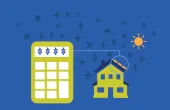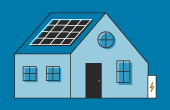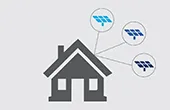Your air conditioner is likely the most energy-hungry electrical appliance in your home, and in warm months, it’s almost always on! If you’re looking to cut down on your electrical bill or estimate how many solar panels you need to keep your home up and running, understanding how many watts of electricity your air conditioning (AC) setup uses is one important piece of the puzzle.
Key takeaways about powering an air conditioner
- On average, air conditioners use 500 to 4,000 watts of electricity. Actual energy usage depends heavily on what kind of air conditioner you’re using (window vs. central). It costs an average of $98 to run a central AC system for a month, and $1,178 to run for a year
- It costs an average of about $27 to run a window AC unit for a month, and $320 to run for a year
- The best way to save on electricity is to install solar panels. Start comparing your options on the EnergySage Marketplace today.
In this article
- How much electricity does an air conditioner use?
- Definitions: watts, volts, amps, and more
- How much does it cost to power an air conditioner?
- How many solar panels does it take to run an air conditioner?
- What size battery do you need to backup an air conditioner?
- How much money can solar panels save you?
How much electricity does an air conditioner use?
On average, an air conditioner uses 500 to 4,000 watts of electricity, depending on the type of unit. Most central air conditioners use between 15 and 60 amps, and about 240 volts, while a window AC unit uses anywhere from 3 to 20 amps and 120 volts. A central AC unit typically uses between 3,000 and 4,000 W, and a window AC unit uses between 500 and 1400 W.
Importantly, air conditioners generally have a much lower “running” wattage than their stated wattage – this is because they cycle on and off throughout the day. As a general rule of thumb, air conditioners cycle on and off 2-3 times each hour for about 15-20 minutes at a time, which is about 35 minutes in every hour. So, a 3,000-watt central air conditioner actually will use about 1,950 watts each hour, and a 1,000-watt window AC unit will use about 650 watts each hour.
How much electricity does a central AC system use?
On average, a central AC system uses 3,000 to 4,000 W. Over the course of a year, assuming it’s run for about 5 months total, an air conditioner might cost about $1,178 to power – that’s about $98 per monthly electricity bill. In practice, you’ll likely be using your AC irregularly throughout the year: more in warmer months, and less in colder months. Therefore, that $98/month cost will probably be much higher in the summer, and much lower in the winter.
Your electricity usage and bill is measured in kilowatt-hours (kWh), which is a measurement of wattage over time. One kilowatt (kW) is 1,000 Watts (W), which means that powering a typical air conditioner for one day uses about 55 kWh of electricity.
How many watts do central air conditioners use? Breakdown by time period
| Central air conditioner wattage | Actual energy usage | Length of time powered | kWh of electricity used |
|---|---|---|---|
| 3,500 W | 2,275 W | 1 hour | 2.3 kWh |
| 3,500 W | 2,275 W | 1 day | 55 kWh |
| 3,500 W | 2,275 W | 1 week | 382 kWh |
| 3,500 W | 2,275 W | 1 month | 1,638 kWh |
| 3,500 W | 2,275 W | 1 year | 8,304 kWh* |
*Assuming 5 months of total running time per year
We’ll mostly be referring to the electricity used by air conditioners in terms of kWh in this article. The reason is simple: your electric bill is measured in kWh, and you get charged based on the kWh of electricity you use per month!
How much electricity does a window AC unit use?
On average, a window AC system uses 500 to 1,400 W. Over the course of a year, assuming it’s run for about 5 months total, an air conditioner might cost about $320 to run – that’s about $27 on each of your monthly electricity bills. Just like a central AC system, you’ll likely be using your window AC irregularly throughout the year: more in warmer months, and less in colder months. Therefore, that $27/month cost will probably be much higher in the summer, and much lower in the winter.
One kilowatt (kW) is 1,000 Watts (W), which means that powering an average window air conditioner for one day uses about 15 kWh of electricity.
How many watts do window air conditioners use? Breakdown by time period
| Air conditioner wattage | Actual energy usage | Length of time powered | kWh of electricity used |
|---|---|---|---|
| 950 W | 618 W | 1 hour | 0.618 kWh |
| 950 W | 618 W | 1 day | 15 kWh |
| 950 W | 618 W | 1 week | 104 kWh |
| 950 W | 618 W | 1 month | 451 kWh |
| 950 W | 618 W | 1 year | 2,256 kWh* |
*Assuming 5 months of total running time per year
How many volts and amps does an air conditioner use?
The wattage of an appliance is determined from its voltage and amperage. You can use the yellow EnergyGuide label on your air conditioning to determine the volts and amps it uses.

Using the above label, here’s how you can calculate volts and amps:
- Calculate the estimated yearly electricity usage by dividing the estimated yearly energy cost ($143) by the national average electricity cost per kWh (12.4 cents): $143 / $0.124/kWh = 1,153 kWh.
- Translate energy consumption to watt-hours (Wh) by multiplying the label’s kWh by 1,000. This gives you 1,153,000 Wh.
- Divide 1,153,000 Wh by the number of days in a year (365), which gives you 3,159 Wh per day.
- Divide 3,159 Wh per day by the number of hours in a day (24), to get an average hourly wattage of 132 W.
- air conditioners usually use 120 volt outlets. Divide the 132 W by 120 volts to get the amperage for your appliance: 132 W / 120 V = 1.1 amps.
Watts, amps, voltage, and more: what do they mean?
There are a lot of terms you can use to describe how electricity flows and is used by appliances. We’ve already mentioned most of them – here are a few definitions to keep things straight:
- Volts (V): volts (short for voltage) are measures of electrical pressure differences. Put simply, voltage is the speed of electricity passing through a circuit.
- Amps (A): amps (short for amperes) are a measure of electrical current. Put simply, amps are the amount of electrons (which make up electricity) flowing through a circuit.
- Watts (W) and kilowatts (kW): multiplying volts x amps gets you watts (or wattage). Put simply, watts are the rate of electricity consumption. A kilowatt is just 1,000 watts.
- Kilowatt-hours (kWh): lastly, kilowatt-hours are how your electric bill measures your energy usage. Simply put, kilowatt-hours are electricity consumption over time.
You can think of all of these terms like water flowing through a pipe. Voltage is the water pressure, amps are the amount of water flowing past any point, and wattage is the overall rate of water flow through the pipe.
How much does it cost to power an air conditioner?
When you get your monthly electric bill, you only get to see the total amount you’re charged, not how much each appliance contributes to your final bill. Based on an average running wattage of 2,275 W for central air conditioners (amounting to 8,304 kWh/year) and 950 W for window air conditioners (amounting to 2,256 kWh/year), and using state average electricity rates, here’s how the cost to run an air conditioner pans out over the course of a month and a year:
Monthly and yearly costs to run a central air conditioner by state
| State | Average electricity rate | Cost per month | Cost per year |
|---|---|---|---|
| California | 22.00 ¢ / kWh | $152 | $1,827 |
| New York | 20.59 ¢ / kWh | $142 | $1,710 |
| Texas | 12.56 ¢ / kWh | $87 | $1,043 |
| Massachusetts | 22.59 ¢ / kWh | $156 | $1,876 |
| Florida | 12.21 ¢ / kWh | $84 | $1,014 |
| Virginia | 12.58 ¢ / kWh | $87 | $1,045 |
| New Jersey | 16.20 ¢ / kWh | $112 | $1,345 |
| Maryland | 14.48 ¢ / kWh | $100 | $1,202 |
| Washington | 10.38 ¢ / kWh | $72 | 862 |
| US Average | 14.19 ¢ / kWh | $98 | $1,178 |
Note: average electricity rates are based on October 2021 data from the U.S. Energy Information Administration (EIA).
Monthly and yearly costs to run a window air conditioner by state
| State | Average electricity rate | Cost per month | Cost per year |
|---|---|---|---|
| California | 22.00 ¢ / kWh | $41.30 | $496 |
| New York | 20.59 ¢ / kWh | $38.67 | $463 |
| Texas | 12.56 ¢ / kWh | $25.58 | $283 |
| Massachusetts | 22.59 ¢ / kWh | $42.42 | $509 |
| Florida | 12.21 ¢ / kWh | $22.92 | $275 |
| Virginia | 12.58 ¢ / kWh | $23.67 | $284 |
| New Jersey | 16.20 ¢ / kWh | $30.42 | $365 |
| Maryland | 14.48 ¢ / kWh | $27.17 | $326 |
| Washington | 10.38 ¢ / kWh | $19.50 | $234 |
| US Average | 14.19 ¢ / kWh | $26.67 | $320 |
Note: average electricity rates are based on October 2021 data from the U.S. Energy Information Administration (EIA).
Looking to offset your electric bills (and the energy these appliances use) with solar? When you sign up (for free!) on the EnergySage Marketplace, you can compare solar quotes from high-quality, local solar installers. Make sure to keep in mind your current and future electricity usage, and talk about how that could change with your installer for the most accurate quotes.
Calculate how much energy your own air conditioner uses
Remember that yellow Energy Saver sticker we mentioned above? If you want to know how much electricity your air conditioner uses (or at least is supposed to use), take the estimated yearly electricity use in kWh – this is probably your best bet for an accurate number. Simply multiply this number by the average electricity rate in your area to get an estimate of how much you spend to power your air conditioner each year. For an estimated monthly cost, divide the estimated yearly cost by 12.
Heat pumps are an efficient alternative to traditional AC
Air source heat pumps are an efficient electric heating and cooling option for your home or business, and are a great alternative to traditional central or window AC. You may have heard of “mini-splits” or “ductless AC” before – that’s just another way to talk about heat pumps. Even in cold climates, heat pumps are usually far more efficient (and therefore less expensive) than air conditioning.
How many solar panels does it take to run an air conditioner?
Average central AC units use between 3,000 and 4,000 watts of electricity to stay powered. On average, solar panels are rated at around 350 W, meaning you’ll need about ten panels to power most central air conditioners. For a typical window AC unit that uses just under 1,000 W, that’s 2 to 3 solar panels.
Keep in mind, air conditioners don’t always use that much electricity, but to power them when they are consuming the most energy, you’ll need to design a solar system that can handle the higher usage times.
See what electricity costs near you
The more expensive your electricity is, the more you’ll pay to power your air conditioning and other home appliances. Curious how much electricity costs near you? Click on your state to learn more:
Frequently asked questions about powering an air conditioner
If you’re on a time-of-use (TOU) rate plan, you are charged different amounts for electricity throughout the day. In general, it’s cheaper to use appliances during “off-peak” hours, which are usually overnight.
Just about all popular home batteries are capable of powering an air conditioner: most lithium-ion batteries like the Tesla Powerwall or Generac PWRcell have a power rating of 4 to 5 kW or higher, and 10+ kWh of usable capacity. Air conditioners use 500 to 4,000 W (0.5 to 4.0 kW) of power at any one time and 4 kWh over the course of a day – meaning most batteries will not be suitable on their own for backing up your air conditioner. A typical home battery will likely have the power rating to get your AC going, but you’ll need multiple batteries to fully back up a central air conditioning unit for a long period of time.
ENERGY STAR is a U.S. government-backed system that certifies how energy efficient appliances are. If an appliance is better than the average appliance in its category by a certain amount, it is labeled as “ENERGY STAR certified”. ENERGY STAR appliances cost less money to run, given that they are more efficient with the electricity they use.
How much money can solar panels save you?
Solar savings vary widely, and your unique savings depends on factors like electricity usage, your location, electric rates and plans, and more. In general, most homeowners can expect to save somewhere between $10,000 and $30,000 over the lifetime of a solar panel system. On average, it takes between 7 and 8 years for most homeowners who shop for solar on EnergySage to get their solar panels to pay for themselves.
Going solar is one of the most effective ways to reduce or eliminate your electric bill, and you should make sure you are getting several quotes from reputable installers before you decide to move forward. Visit the EnergySage Marketplace to get solar quotes from installers in your area and begin comparing options.






